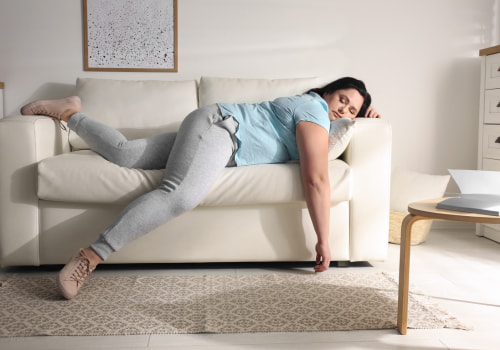Are you aware of the health risks of sedentary lifestyles? While there is no doubt that genetic factors have been shown to contribute to obesity, it is also the daily choices that we make which can ultimately determine our physical, mental and emotional health.
The purpose of this article is to take an in-depth look at the negative effects of certain sedentary behaviors. By highlighting these seemingly mundane threats, it will be much easier for you to enact the appropriate changes well in advance. Let us jump right in.
What is a Sedentary Lifestyle?
The definition of sedentary lifestyles will vary between medical professionals. However, all the attempts at defining what sedentary means focus on some common elements. Those who lead sedentary lifestyles perform little to no exercise, spend the majority of their days sitting or lying down, and oftentimes lack the motivation to embrace a healthy diet.
Unfortunately, western societies are now only beginning to understand the profound health problems caused by lack of exercise. These issues are exacerbated by other habits common among sedentary people such as a having a poor diet, getting inadequate sleep and consuming too many calories. All these behaviors reinforce each other and expose people living a sedentary lifestyle to a variety of unhealthy consequences.
Signs You May be Living a Sedentary Lifestyle

Now that we have briefly reviewed some of the dangers of sedentary lifestyles, an important question needs to be asked. What are some of the main signs that you may have inadvertently adopted such practices? The chances are high that you might already notice some physical changes that were not present in the past. A handful of the most commonly reported include:
- Elevated cholesterol and high blood pressure.
- Poor circulation (particularly to the lower extremities).
- Having been diagnosed with heart-related illnesses such as cardiovascular disease.
- Pronounced weight gain over long periods of time.
- A weakened immune system (getting sick more often).
- Adult-onset (Type 2) diabetes.
Note that these physical symptoms tend to emerge slowly as opposed to presenting themselves within a short time frame. This is also why the health risks associated with poor physical health are rather insidious in nature. In other words, we might not fully appreciate the dangers until one or more of the issues above begin to emerge.
The Health Risks of a Sedentary Lifestyle
How can inactivity hurt your health? There are several ways in which this question may be addressed. For the sake of clarity, we will adopt a holistic approach. What are some of the mental and physical health risks associated with a sedentary lifestyle?
The Physical Health Risks of Sedentary Lifestyles
These are arguably the most recognised dangers and scientists have been aware of the short- and long-term impacts for decades (if not centuries). As highlighted earlier, some common symptoms can be attributed to the cardiovascular system (hypertension, cardiovascular disease and stroke). Obesity is likewise one of the leading causes of a myocardial infarction (heart attack). However, the threats are far from over.
The effects of sedentary lifestyle on health can also inhibit your mobility due to other issues such as a swelling of the extremities, varicose veins, increased levels of inflammation, and poor muscular conditioning. As it becomes more difficult to perform physical activities that were commonplace at one time, your body mass index (BMI) may further increase; leading to a so-called “runaway effect”.
Another point to mention is that the physical risks attributed to a sedentary lifestyle tend to become more profound as we age. This is the result of several factors. Not only will the metabolism begin to slow down (generally after the age of 60), but it can become more difficult to break stubborn habits that might have been developed over decades. Furthermore, recovering from the medical conditions described in the previous section takes longer and prognoses are not as positive.
The Mental Health Risks of Sedentary Lifestyles
Although the physical dangers are concerning in and of themselves, it also pays to look at the other side of the proverbial coin. After all, our mental and physical health are closely intertwined.
Many medical professionals and psychologists point out that low self-esteem is much more predominant in individuals who are classified as obese. This generally results from a poor body image and feelings of shame. When taken to the extreme, such emotions can quickly devolve into more severe conditions such as anxiety and even clinical depression.
A lack of confidence and inadequate social skills have also been linked to sedentary lifestyles. Many of those who lead inactive lives tend to avoid public affairs and normal activities that others enjoy. Such feelings of isolation can easily compound themselves and once again, it is exceedingly difficult to break such a cycle.
Interestingly enough, neurotransmitters and hormones play an equally important role. Obesity has been linked to lower levels of “feel-good” chemicals such as serotonin and epinephrine (both risk factors for conditions such as depression and generalised anxiety disorder). A lesser-known and equally disturbing issue is that some common medications intended to alleviate these emotional states may sometimes cause weight gain; leading individuals to believe that no options remain.
Mitigating the Risks of a Sedentary Lifestyle
We can now see that breaking such a destructive cycle is no easy task. Enacting positive changes will require time and effort. However, it is still within your power to make dramatic improvements if you are concerned about the risks outlined above. The first step is to adopt a mindset that is open to transformation and to clearly define your goals. It will then be much easier to gauge your progress along the way.
However, most of us leave busy lives and the notion of simply retiring to a weight-loss retreat is hardly realistic. Let’s therefore take a look at some habits that can be adopted within both home and work environments.

At Home
In truth, the majority of effort devoted to a healthy lifestyle will occur within the comfort of your own home. For example, avoid becoming distracted while eating in order to pay more attention to the food that is being consumed as well as the overall experience (which should always be pleasurable). Other tips include:
- Counting the number of calories ingested on a daily basis.
- Devoting one room of your home to physical activity.
- Obtaining at least seven hours of sleep each night.
- Relying upon other family members for support.
- Setting realistic short-term targets in order to reach long-term goals.
The good news is that any habits developed within the home can easily translate into the professional environment. This leads us to the next point.
At Work
If you are constantly at work or otherwise away from home, what strategies can be put in place? One important method is to maintain the same level of discipline (although this may be challenging in the beginning). Still, it can be easy to succumb to temptation in real-world environments. This is why some additional techniques can represent invaluable assets at your disposal. Consider these approaches:
- Eliminate fast food and similar processed substances (even if they happen to be convenient).
- Choose healthy snacks between meals such as fruit, vegetables or legumes).
- Make it a point to stand up and walk around for at least ten minutes for each hour that you remain seated.
- Try to enjoy your meal breaks outdoors if the weather permits.
- Drink plenty of water, as this can help to stave off pangs of hunger.
- When practical, walk or ride a bicycle to work as opposed to driving or relying upon mass transportation.
All of these approaches are extremely effective and you will be pleased with the results.
There is no Better Time to Change Than the Present
On a final note, it could still be difficult to lose weight even after enacting the changes recommended above (such as if you have suffered an injury that has left you immobile). This is why a growing number of individuals are choosing to augment these strategies with the help of a Spatz3 adjustable gastric balloon. Spatz3 balloons can remain in place for extended periods of time (unlike traditional configurations) and as their dimensions are able to be modified, they ultimately provide personalised solutions that offer a greater degree of comfort.
The health risks of sedentary lifestyles are serious indeed and yet, keep in mind that this is one of the few conditions which you have active control over if you are able to adopt the proper mindset.


